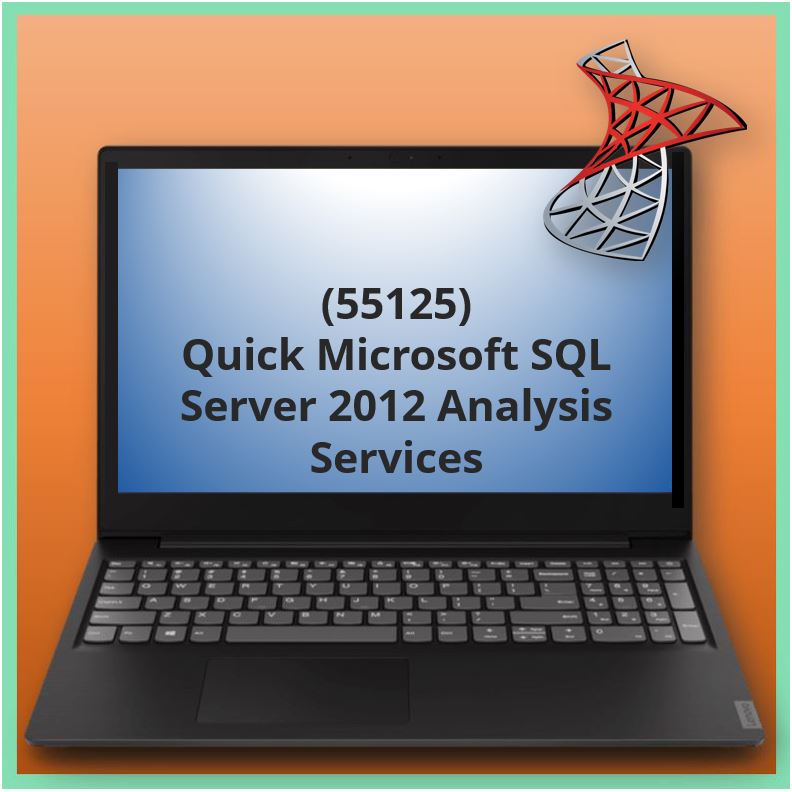Aangeboden leervormen

Quick Microsoft SQL Server 2012 Analysis Services (55125)
About this Course
This course is intended for IT professionals who are interested in quickly learning how to utilize an Analysis Services multidimensional or tabular solution. This course also discusses how to use the Analysis Services development tools to create both multidimensional and tabular projects, and follows with explanations on how to use the management and administrative tools to manage both Analysis Services solutions.
At Course Completion
After completing this course, students will be able to:
· Understand common Analysis Services solutions.
· Understand version changes of SSAS from 2008-2014.
· Understand Analysis Services installation and architecture.
· Understand how to choose the right model.
· Understand the Analysis Services tools available.
· Understand the multidimensional model.
· Utilize data sources and data source views.
· Create a cube.
· Understand and utilize dimensions.
· Understand and utilize attributes.
· Understand and utilize relationships.
· Understand and utilize hierarchies.
· Understand and utilize measures and measure groups.
· Understand and utilize calculated members.
· Understand and utilize perspectives.
· Understand and utilize translations.
· Browse perspectives and translations.
· Understand and utilize deployment options.
· Understand and utilize processing strategies.
· Understand and utilize security.
· Deploy a multidimensional model.
· Understand the tabular model.
· Create a tabular project.
· Analyze the data using Microsoft Excel.
· Create and configure calculated measures and calculated fields.
· Backup and Restore.

Voor wie
This course is intended for SQL professionals, Microsoft Analysis Services cube and report developers, and business intelligence professionals.
Programma
Module 1: Course Overview
This module explains how the class will be structured and introduces course materials and additional administrative information.
Lessons
· Introduction
· Course Materials
· Facilities
· Prerequisites
· What We'll Be Discussing
Lab : Course Overview
· None
After completing this module, students will be able to:
· Successfully log into their virtual machine.
· Have a full understanding of what the course intends to cover.
Module 2: Introduction to Microsoft SQL Server Analysis Services
Analysis Services is an online analytical processing (OLAP) database, a type of database that is highly optimized for the kinds of queries and calculations that are common in a business intelligence environment. In this module we aim to get you familiar with the recent changes, explore the architecture options, and explain the tools available.
Lessons
· Common Analysis Services Solutions
· Version Changes of SSAS from 2008-2014
· Analysis Services Installation and Architecture: One Product, Two Models
· Choosing the Right Model
· Analysis Services Tools
Lab : Introduction to Microsoft SQL Server Analysis Services
· Analysis Services Tools
After completing this module, students will be able to:
· Understand common Analysis Services solutions.
· Understand version changes of SSAS from 2008-2014.
· Understand Analysis Services installation and architecture.
· Understand how to choose the right model.
· Understand the Analysis Services tools available.
Module 3: The Multidimensional Solution
In the multidimensional model, data is modeled as a series of cubes and dimensions. In this module we will explore how to create and configure a cube. Dimensions will be discussed in a later module.
Lessons
· Understanding the Multidimensional Model
· Utilizing Data Sources and Data Source Views
· Creating a Cube
Lab : The Multidimensional Solution
· Creating a Cube
After completing this module, students will be able to:
· Understand the multidimensional model.
· Utilize data sources and data source views.
· Create a cube.
Module 4: Dissecting with Dimensions
Dimensions are the categories by which you slice your data to view specific quantities of interest. In this module we will explore dimensions and how they are used in conjunction with attributes, relationships, and hierarchies.
Lessons
· Developing Dimensions
· Utilizing Attributes
· Relating with Relationships
· Handling Hierarchies
Lab : Dissecting with Dimensions
· Developing Dimensions
· Relating with Relationships
· Handling Hierarchies
After completing this module, students will be able to:
· Understand and utilize dimensions.
· Understand and utilize attributes.
· Understand and utilize relationships.
· Understand and utilize hierarchies.
Module 5: Managing Measures
Each cube is made up of one or more measure groups, and each measure group in a cube contains one or more measures. In this module we will explore all there is to know about measures and measure groups, and we’ll also cover calculated members.
Lessons
· Measures and Measure Groups
· Calculated Members
Lab : Managing Measures
· Measures and Measure Groups
· Calculated Members
After completing this module, students will be able to:
· Understand and utilize measures and measure groups.
· Understand and utilize calculated members.
Module 6: Configuring Cube Options
Perspectives have the ability to hide certain parts of a complex model, which can help usability, and security roles can be used to deny access to specific rows of data from tables to specific users. Translations allow the metadata of a multidimensional model to appear in different languages for users with different locales on their desktops. In this module we will cover both configurations and the options available.
Lessons
· Understanding Perspectives
· Utilizing Translations
· Browsing Perspectives and Translations
Lab : Configuring Cube Options
· Browsing Perspectives and Translations
After completing this module, students will be able to:
· Understand and utilize perspectives.
· Understand and utilize translations.
· Browse perspectives and translations.
Module 7: Deploying
Deploying an Analysis Services project creates the defined objects in an instance of Analysis Services. In this module we will explore deployment options, processing strategies, and security.
Lessons
· Examining Deployment Options
· Processing Strategies
· Exploring Security
Lab : Deploying
· Deploying the Multidimensional Model
After completing this module, students will be able to:
· Understand and utilize deployment options.
· Understand and utilize processing strategies.
· Understand and utilize security.
· Deploy a multidimensional model.
Module 8: The Tabular Solution
Tabular models are in-memory databases in Analysis Services. In this module we will explore the tabular model, create a tabular project, deploy and query the solution using Data Analytic Expressions (DAX).
Lessons
· Understanding the Tabular Model
· Creating a Tabular Project
· Deploying
· Browsing the Model
· Querying the Solution and Understanding DAX
· Maintaining and Optimizing
Lab : The Tabular Solution
· Creating a Tabular Project
· Analyze in Excel
· Calculated Measures and Calculated Fields
· Backup and Restore
After completing this module, students will be able to:
· Understand the tabular model.
· Create a tabular project.
· Analyze the data using Microsoft Excel.
· Create and configure calculated measures and calculated fields.
· Backup and Restore.
Voorkennis
Before attending this course, students must:
· A general familiarity with databases prior to the class.
· Additionally, working knowledge of Microsoft SQL Server or Microsoft Office applications is beneficial.
Examen
NVT
Duur training
Open leercentrum: 2 dagen







